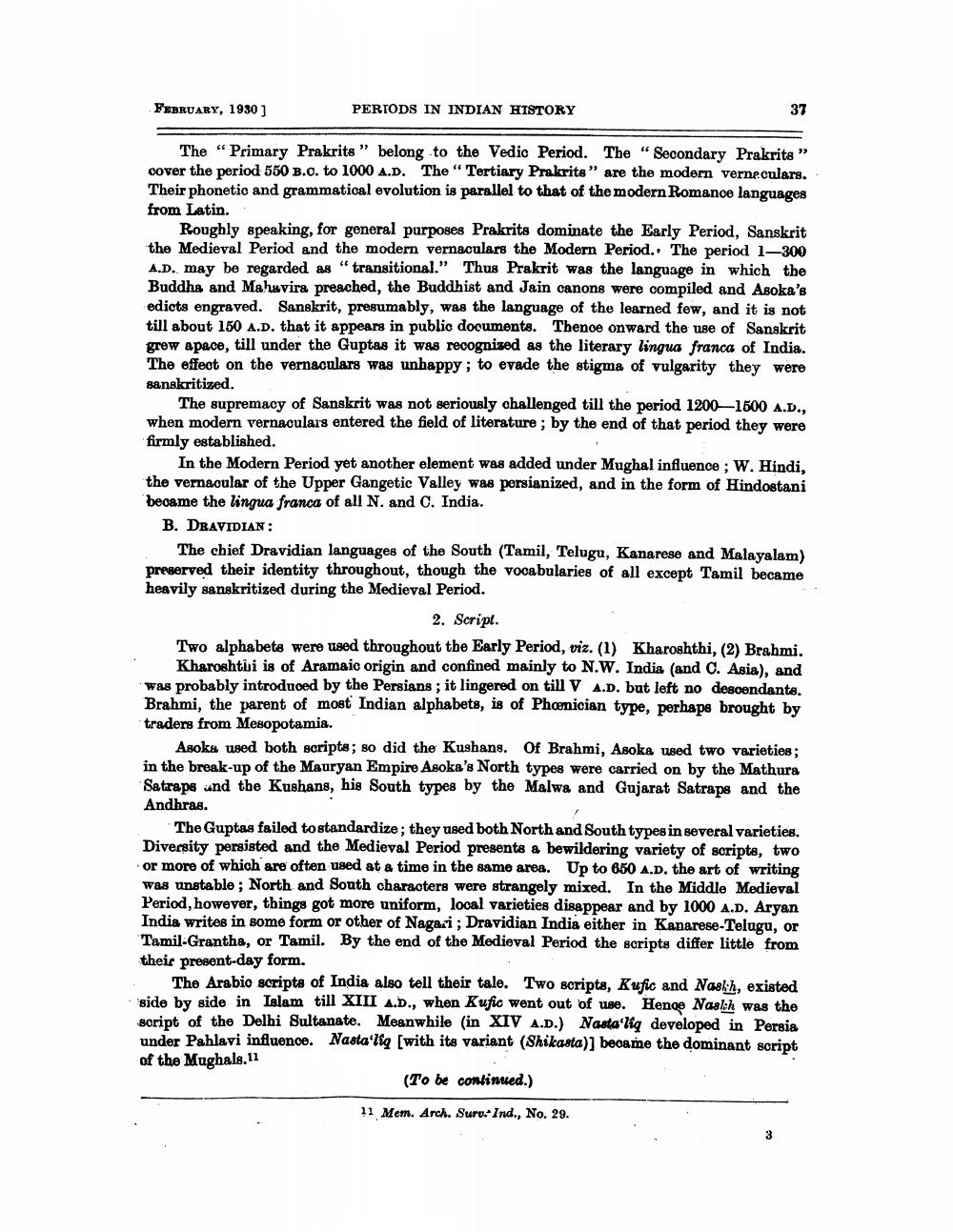________________
FEBRUARY, 1930 ]
PERIODS IN INDIAN HISTORY
The "Primary Prakrits" belong to the Vedic Period. The " Secondary Prakrits" cover the period 550 B.C. to 1000 A.D. The “Tertiary Prakrits" are the modern verneculars. Their phonetic and grammatical evolution is parallel to that of the modern Romanoe languages from Latin.
Roughly speaking, for general purposes Prakrits dominate the Early Period, Sanskrit the Medieval Period and the modern vernaculars the Modern Period.. The period 1-300 A.D. may be regarded as “transitional.” Thus Prakrit was the language in which the Buddha and Mahavira preached, the Buddhist and Jain canons were compiled and Asoka's edicts engraved. Sanskrit, presumably, was the language of the learned few, and it is not till about 150 A.D. that it appears in public documents. Thenoe onward the use of Sanskrit grew apace, till under the Guptas it was recognized as the literary lingua franca of India. The effect on the vernaculars was unhappy; to evade the stigma of vulgarity they were sanskritized.
The supremacy of Sanskrit was not seriously challenged till the period 1200-1500 A.D., when modern vernaculais entered the field of literature; by the end of that period they were firmly established.
In the Modern Period yet another element was added under Mughal influence ; W. Hindi, the vernacular of the Upper Gangetic Valley was persianized, and in the form of Hindostani became the lingua franca of all N. and C. India. B. DRAVIDIAN :
The chief Dravidian languages of the South (Tamil, Telugu, Kanarese and Malayalam) preserved their identity throughout, though the vocabularies of all except Tamil became heavily sanskritized during the Medieval Period.
2. Script. Two alphabets were used throughout the Early Period, viz. (1) Kharoshthi, (2) Brahmi.
Kharoshtii is of Aramaio origin and confined mainly to N.W. India (and C. Asia), and was probably introduced by the Persians; it lingered on till V A.D. but left no descendants. Brahmi, the parent of most Indian alphabets, is of Phoenician type, perhaps brought by traders from Mesopotamia.
Asoka used both scripts; so did the Kushang. Of Brahmi, Asoka used two varieties; in the break-up of the Mauryan Empire Asoka's North types were carried on by the Mathura Satraps ind the Kushans, his South types by the Malwa and Gujarat Satraps and the Andhras.
The Guptas failed to standardize; they used both North and South types in several varieties. Diversity persisted and the Medieval Period presents a bewildering variety of scripts, two or more of which are often used at a time in the same area. Up to 650 A.D. the art of writing was unstable ; North and South characters were strangely mixed. In the Middle Medieval Period, however, things got more uniform, local varieties disappear and by 1000 A.D. Aryan India writes in some form or other of Nagari; Dravidian India either in Kanarese-Telugu, or Tamil-Grantha, or Tamil. By the end of the Medieval Period the scripts differ little from their present-day form.
The Arabio scripts of India also tell their tale. Two soripts, Kufic and Naskh, existed side by side in Islam till XIII A.D., when Kufic went out of use. Henge Naslh was the script of the Delhi Sultanate. Meanwhile in XIV A.D.) Nasta'liq developed in Persia under Pahlavi influence. Nasta'lq [with its variant (Shikasta)] became the dominant script of the Mughals.11
(To be continued.)
11 Mem. Arch. Suro-Ind., No. 29.




